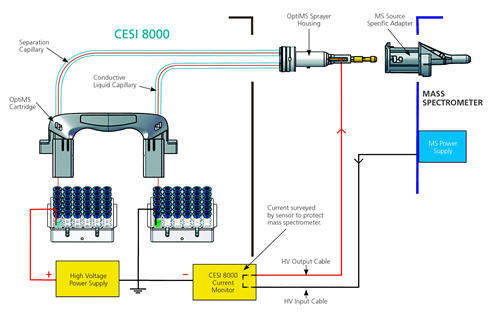Porous Tip Sheathless CE-MS Interface
Moini proposed to etch the end of the CE separation capillary with hydrofluoric acid (HF) which renders the end of the fused-silica capillary porous [1]. The capillary is placed in a stainless steel ESI needle. Co-axially a conductive liquid is delivered to the outside of the porous end which makes a hydraulic electrical contact between the ESI needle and the CE separation BGE. This essential concept has been implemented by Beckman Coulter in a prototype system in 2010 and brought to market very recently (now Sciex Separations, CESI 8000 High Performance Separation-ESI Module, figure taken from the website).

In the set-up shown in the diagram (taken from it is essential to realize that unlike the co-axial sheath-liquid CE-MS interface described before, the voltage for electrospray is applied to the spray needle. This power supply is part of the MS but connects to the spray needle. The electrospray voltage from the MS is controlled by the so-called current monitor. The CE capillary is grounded through the conductive liquid capillary in the outlet vial of the CE,
To allow the formation of the porous tip by HF etching, it is required that the CE capillary has a thin capillary wall. Therefore, the use of non-standard, 150 µm o.d. and 20-30 µm i.d. fused-silica capillaries is mandatory. As the spray is formed solely from the BGE an EOF must exist. The usage of positively or negatively coated capillaries that generate an EOF has been reported or a slight gas pressure on the inlet vial is applied when coated, neutral capillaries are used [2].
In principle one could use the CESI 8000 and interface with MS systems that provide the ESI voltage from the MS inlet side (Bruker and Agilent Technologies) thereby obviating the CESI 8000 Current Monitor. The system described here though, is a highly proprietary solution requiring the usage of a Sciex Separations CESI 8000 High Performance Separation-ESI Module, MS Source Specific Adapter, CE separation capillaries with porous tip and Sciex mass spectrometers (Thermoscientif Orobitrap is supported too).
Several groups have reported their results with the prototype CESI 8000 system. [2-6]. Under comparable conditions, the porous tip sheathless interface typically is about 50-fold more sensitive than the co-axial sheath-liquid interface. Longevity of the porous tip capillaries of about 200 injections has been reported [6]. Since the usage of standard 365x50 or x75 µm i.d. capillaries is prohibited by design of the interface, replacement capillaries have to be acquired from the manufacturer
![]()
[1] Moini M (2007) Anal Chem 79:4241-4246
[2] Busnel J.M., Schoenmaker B., Ramautar R., Carrasco-Pancorbo A., Ratnayake C., Feitelson J.S., Chapman J.D., Deelder A.M, Mayboroda O.A. (2010) Anal. Chem. 82, 9476-9483
[3] Haselberg R., Ratnayake C.K., de Jong G.J., Somsen G.W. (2010) J. Chromatogr. A 1217, 7605-7611
[4] Faserl K., Sarg B., Kremser L., Lindner H. (2011) Anal. Chem. 83:7297-7305
[5] Ramautar R., Busnel J.M., Deelder A.M., Mayboroda O.A. (2012) Anal. Chem. 84 885-892
[6] Hirayama A., Tomita M., Soga T. (2012) Analyst 137 5026-5033
